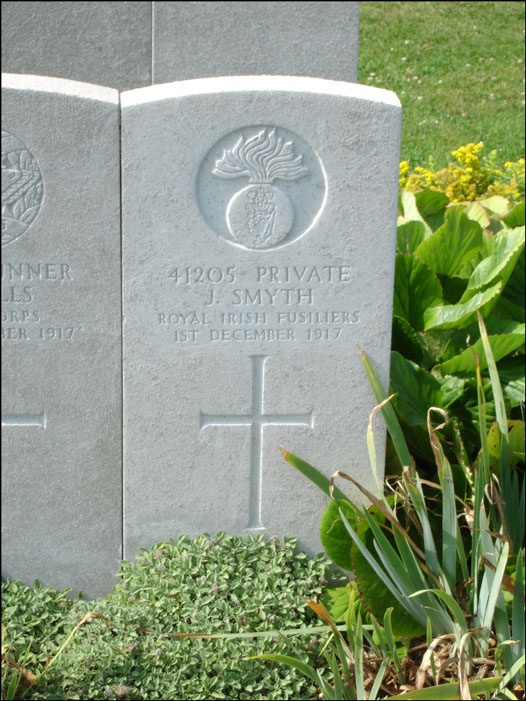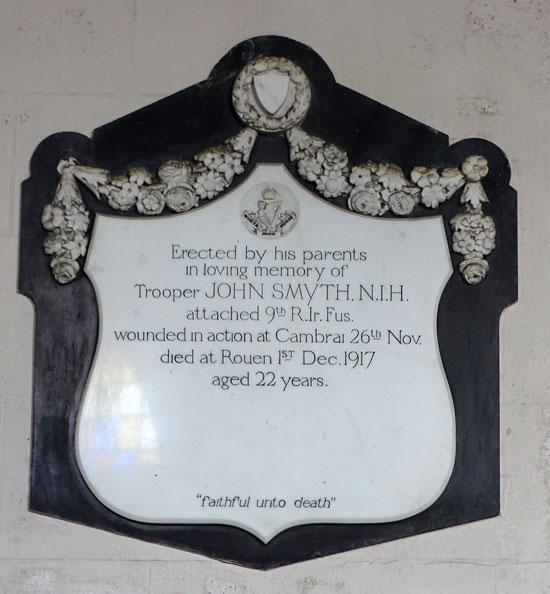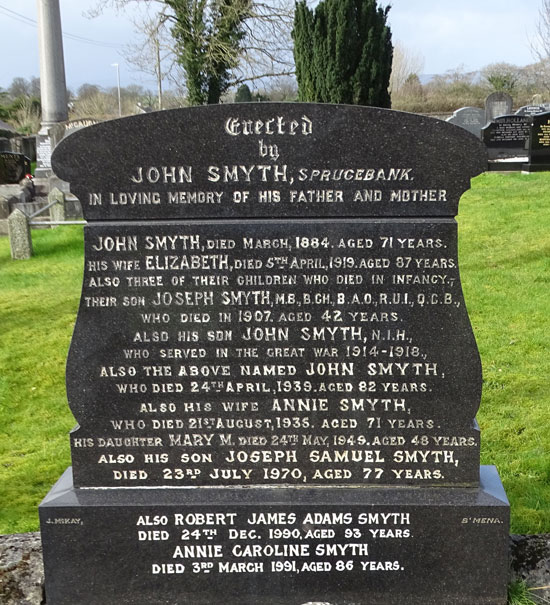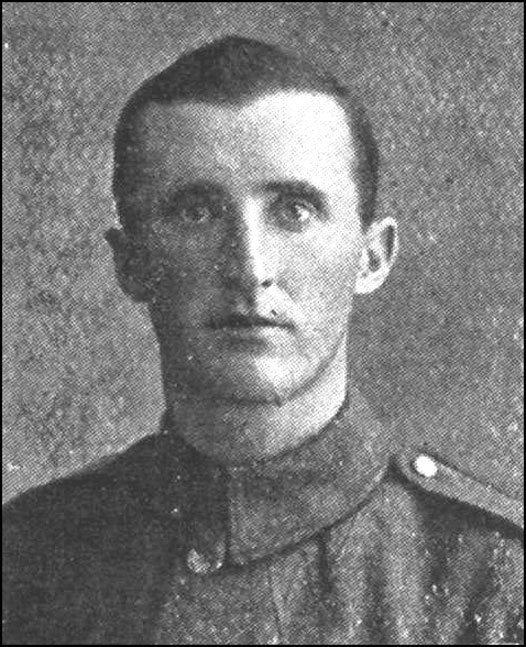![]() In memoriam
In memoriam ![]()
Private John Smyth

John Smyth was born on 17 December 1894 at Ballymacombs, Bellaghy, County Londonderry, the third of eight children of farmer John Smyth and his wife Annie (nee Adams). He grew up working on his father's farm, and was educated at Innisrush and Portglenone.
Smyth enlisted in the North Irish Horse at Antrim on 1 February 1915 (No.1435). He embarked for France with F Squadron on 17 November that year.
In June 1916 F Squadron joined with C Squadron and the 6th (Inniskilling) Dragoons Service Squadron to form the 2nd North Irish Horse Regiment. In September 1917 the regiment was dismounted and most of its officers and men were transferred to the 9th (Service) Battalion, Royal Irish Fusiliers – which was renamed the 9th (North Irish Horse) Battalion. Like most of the men, Smyth was transferred to the battalion on 20 September. He was issued a new regimental number – 41205.
In November and December 1917 the 9th Battalion played a role in the Battle of Cambrai, first going into action in the attack on the village of Moeuvres on 22-23 November. The battalion war diary for those days reads as follows:
[22 November] The Battn moved up at 6.30 a.m. to a position N. of Bapaume & Cambrai Road arriving at 8.30 a.m. Here the Battn waited for an order to attack Inchi when Moeuvres was taken by the 12th Royal Irish Rifles. At 11.45 a.m. the 12th R. Ir. Rifles captured village of Moeuvres. It was unable to clear trenches East of village. At 5.30 p.m. Battn moved up to support 12th R. Ir. Rifles in the village of Moeuvres. At 5.45 p.m. 12th R. Ir. Rifles reported driven out of village. At 8.30 p.m. Battn less 'D' Coy counter attacked village of Moeuvres but was driven back to trenches immediately south of the village, where it took up a defensive position for the night.
[23 November] Battn attacked Moeuvres at 10.30 a.m. At 11 a.m. Battn reported in village. At 11.45 a.m. enemy counter attacked from trenches West of village. 12.15 p.m. counter attack driven off. At 4.30 .p.m village evacuated by Battn on account of supports not coming up. 5 p.m. 'C' & 'D' Coys took up position on Sunken Road South of village and 'A' & 'B' Coys went back to trenches North of Bapaume & Cambrai Road.
Casualties for 22nd & 23rd: Officers killed 1. Officers wounded 6. ORs 82 casualties.
Smyth was one of the 82 casualties. He was evacuated to No.6 General Hospital at Rouen (or No.5 General Hospital according to some records), where he died of wounds on 1 December 1917.
His company commander wrote to Smyth's family, "Having been in the same squadron of the North Irish Horse myself, I have known Private Smyth for some time, and have always found him a fine soldier and popular among his comrades."
Private Smyth is buried in the St. Sever Cemetery Extension, Rouen, Seine-Maritime, France, grave P.V.C.6B. His gravestone inscription reads:
41205 PRIVATE
J SMYTH
ROYAL IRISH FUSILIERS
1ST DECEMBER 1917

Tamlaght O'Crilly Lower Church of Ireland, Innishrush

Innishrush Church of Ireland graveyard
Smyth's eldest brother, Lance Corporal Thomas Johnston Smyth, served in France in the 2nd Battalion Otago Regiment, New Zealand Expeditionary Force, and was awarded a Military Medal for "acts of gallantry in the field".
Image of CWGC headstone kindly provided by Steve Rogers, Project Co-ordinator of the The War Graves Photographic Project, www.twgpp.org. Image of Private Smyth sourced from De Ruvignys Roll of Honour, Vol.3. Images 3 and 4 kindly provided by Nigel Henderson, Great War Researcher at History Hub Ulster.

